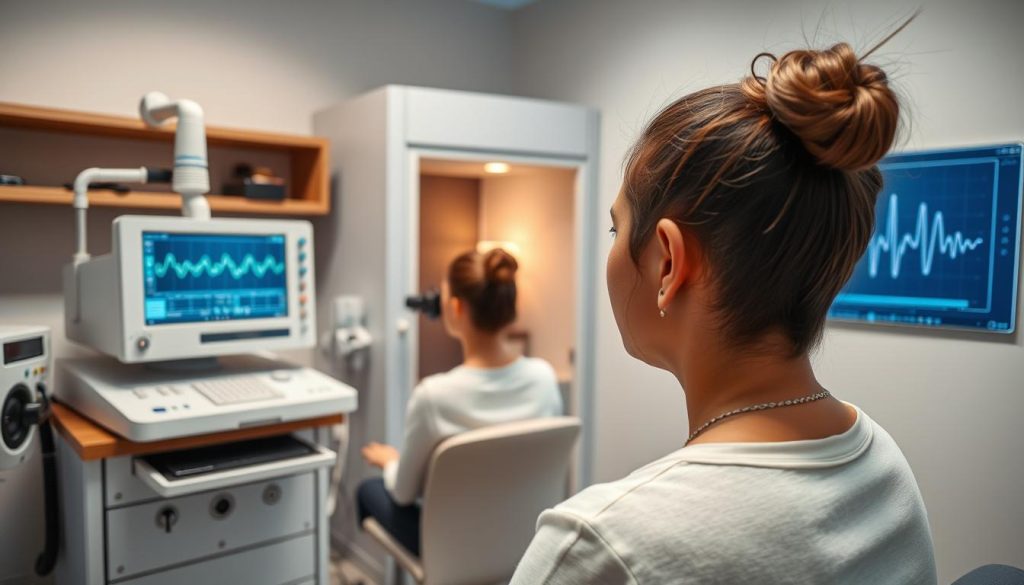Cochlear implant surgery is a groundbreaking solution for severe hearing loss. It has changed many lives by giving back hearing to those with profound loss. This hearing loss treatment has come a long way from its start in the 1950s.
The first cochlear implants were just ideas back then. Now, they are advanced systems that help those who can’t use regular hearing aids. They work by directly stimulating the auditory nerve, helping users hear sounds and understand speech.
In this guide, we’ll look into the details of cochlear implant surgery. We’ll talk about its benefits and how it improves patients’ lives. Our goal is to give you all the information you need about this amazing technology for hearing restoration.
Understanding Cochlear Implant Surgery and Its Purpose
Cochlear implant surgery is a groundbreaking procedure for those with severe hearing loss. It offers hope to those who can’t use regular hearing aids. Let’s look at how these implants work and their parts.
How Cochlear Implants Work
Cochlear implants skip over damaged parts of the inner ear. They send electrical signals to the auditory nerve. This lets the brain understand sound waves as actual sounds.
Difference Between Hearing Aids and Cochlear Implants
Both devices aim to help with hearing, but they work in different ways:
| Feature | Hearing Aids | Cochlear Implants |
|---|---|---|
| Function | Amplify sounds | Bypass damaged hair cells |
| Suitability | Mild to severe hearing loss | Severe to profound hearing loss |
| Installation | External, removable | Surgically implanted |
| Sound quality | Natural, amplified sound | Digital sound representation |
Components of a Cochlear Implant System
A cochlear implant system has both external and internal parts:
- External: Microphone, speech processor, transmitter
- Internal: Receiver-stimulator, electrode array
The external parts pick up and process sound. The internal parts send electrical signals to the auditory nerve. Together, they help people with profound hearing loss to hear.
Candidates for Cochlear Implantation
Cochlear implantation offers hope for those with severe hearing loss. This technology can change lives. But, not everyone is a good fit. Let’s look at who might benefit from this groundbreaking procedure.

Adults and children with profound sensorineural hearing loss are top candidates. If hearing aids don’t help much, cochlear implants might be the solution. The FDA says kids as young as 12 months can get them.
Ideal candidates usually have:
- Severe to profound hearing loss in both ears
- Limited benefit from hearing aids
- No medical conditions that prevent surgery
- Strong support system for rehabilitation
- Realistic expectations about outcomes
Age matters in cochlear implantation. Early treatment in kids can help with language skills. For adults, how long they’ve been deaf can affect success.
“Cochlear implants gave me back the world of sound. It’s not perfect, but it’s life-changing,” shares Sarah, a cochlear implant recipient.
Choosing the right candidate involves a detailed process. It includes hearing tests, medical exams, and psychological assessments. The journey to better hearing begins with a talk with an audiologist or ENT specialist.
Pre-Surgical Evaluation and Assessment Process
Before getting cochlear implant surgery, patients go through a detailed evaluation. This makes sure they’re a good fit and ready for the surgery.
Medical Examinations Required
Doctors run many tests to check if someone is healthy enough for surgery. These tests include blood work, imaging, and heart checks. They look for any risks or problems.
Audiological Testing
Tests to check hearing are key for cochlear implants. They see how much hearing loss there is and if the nerve works right.
- Pure-tone audiometry
- Speech recognition tests
- Tympanometry
- Auditory brainstem response (ABR)

Psychological Preparation
Being mentally ready is important for cochlear implant success. Patients and their families get counseling. They learn what to expect and how to handle challenges.
| Evaluation Component | Purpose |
|---|---|
| Medical Exams | Assess physical fitness for surgery |
| Audiological Tests | Measure hearing loss and nerve function |
| Psychological Counseling | Prepare mentally for the implant process |
This thorough check-up makes sure patients are ready for their cochlear implant journey. It covers everything from the surgery to ongoing care and therapy.
Types of Cochlear Implant Devices Available
The market for sound perception implants offers various options to address different hearing rehabilitation needs. Cochlear implant devices come in multiple designs, each with unique features to enhance auditory experiences.

Leading manufacturers produce advanced cochlear implants, focusing on improved sound quality and user comfort. These devices typically consist of external and internal components. They work together to bypass damaged parts of the ear and stimulate the auditory nerve directly.
When choosing a cochlear implant, consider these key factors:
- Sound processing capabilities
- Battery life and rechargeability
- Water resistance
- Connectivity options for smartphones and other devices
- Size and aesthetics
Some implants feature cutting-edge technologies like artificial intelligence to optimize sound quality in different environments. Others prioritize durability for active lifestyles or offer specialized programming for music appreciation.
| Feature | Standard Implant | Advanced Implant |
|---|---|---|
| Channels | 12-22 | 22-24 |
| Battery Life | 12-16 hours | 18-24 hours |
| Water Resistance | Splash-proof | Waterproof |
| Smartphone Connectivity | Limited | Full integration |
Selecting the right cochlear implant involves careful consideration of individual needs and lifestyle factors. Consulting with hearing specialists ensures patients receive the most suitable device for their hearing rehabilitation journey.
The Step-by-Step Cochlear Implant Surgery Procedure
Cochlear implant surgery is a groundbreaking procedure that can change lives. It helps those with severe hearing loss regain their hearing. This surgery needs a lot of skill and care.
Anesthesia Administration
The surgery starts with general anesthesia. This keeps the patient comfortable and asleep. An anesthesiologist watches over the patient’s health during the surgery.
Surgical Technique
With the patient asleep, the surgeon makes a small cut behind the ear. They then make a space in the skull for the implant. The surgeon carefully puts the electrode array into the cochlea for the best sound.
Duration and Recovery Time
The surgery usually takes 2-4 hours. After, patients rest for a few hours before going home. Most people can go home the same day. It takes about 4-6 weeks to fully recover.
| Surgery Stage | Duration | Key Points |
|---|---|---|
| Anesthesia | 30 minutes | General anesthesia administered |
| Incision and Implantation | 1-2 hours | Electrode array inserted into cochlea |
| Closure and Finishing | 30 minutes | Incision closed, bandage applied |
| Recovery Room | 2-3 hours | Patient monitored post-surgery |
Knowing about cochlear implant surgery helps patients get ready. It sets the stage for their journey to better hearing.
Post-Operative Care and Recovery Guidelines
After getting a cochlear implant, it’s important to take good care of yourself. Follow your surgeon’s advice to heal well and get ready for hearing therapy.
Keeping the wound clean and dry is key. Don’t touch or scratch the incision. Your doctor might suggest using antiseptic solution and antibiotic ointment.
Managing pain is also important. Take your medicine as told. Ice packs can help with swelling and pain. If pain gets worse or doesn’t go away, call your doctor.
- Avoid strenuous activities for 2-4 weeks
- Sleep with your head elevated to minimize swelling
- Do not swim or submerge your head in water until cleared by your doctor
- Attend all follow-up appointments for proper monitoring
Recovery time can vary, but most people go back to work or school in 1-2 weeks. It might take 4-6 weeks to fully heal. Use this time to get ready for hearing therapy.
“Patience and persistence are key during recovery. Each day brings you closer to improved hearing.”
Good care after surgery and sticking to the rehab plan are key for success. Stay positive and follow your care team’s advice for the best outcome.
Activation and Programming of the Device
After cochlear implant surgery, patients start a new journey to hear again. The activation and programming are key for the implants to work well. This starts a few weeks after surgery, giving time for healing.
Initial Mapping Session
The first step is the initial mapping session. An audiologist adjusts the device to fit the patient’s hearing needs. This is the first time the implant is turned on, a big step in their hearing journey.
Fine-Tuning Appointments
After the first turn-on, patients have fine-tuning appointments. These are important for making the implants work their best. The audiologist makes small changes based on what the patient says, making sure the sound is clear and comfortable.
Adaptation Period
The adaptation period is when the brain gets used to new sounds from the implant. This can take months. Patients need to practice and be patient as they get used to their new hearing.
| Stage | Duration | Key Activities |
|---|---|---|
| Initial Mapping | 1-2 hours | Device activation, basic programming |
| Fine-Tuning | Multiple sessions over weeks | Adjustments based on patient feedback |
| Adaptation | 3-12 months | Brain adaptation, hearing exercises |
Rehabilitation and Speech Therapy
After cochlear implant surgery, patients start a journey of learning. They adapt to hearing in new ways. Audiology treatments help them understand the sounds from their implant.
Speech therapy is very important. It teaches patients to recognize speech and sounds around them. They work with professionals to improve listening and speaking.
Auditory training is also key. Patients learn to identify sounds, from simple to complex. This helps their brain get used to new sounds.
- Sound identification exercises
- Speech recognition practice
- Lip-reading techniques
- Music appreciation training
Being consistent is key to success. Patients do exercises at home every day. Family support is also very important for encouragement.
| Rehabilitation Stage | Focus Areas | Duration |
|---|---|---|
| Initial Adaptation | Basic sound awareness | 1-3 months |
| Speech Recognition | Word and sentence comprehension | 3-6 months |
| Advanced Listening | Complex conversations, background noise | 6-12 months |
Rehabilitation is different for everyone. Some progress fast, others take longer. Being patient and persistent is important for success.
Potential Risks and Complications
Cochlear implant surgery is a big step, but it’s key to know the risks. This surgery is usually safe but can face challenges during and after.
Surgical Risks
Like any surgery, cochlear implant surgery has risks. Infection at the incision site is rare but possible. Facial nerve injury, leading to weakness, can happen in some cases.
Balance problems after surgery are common but usually go away with time.
Device-Related Issues
The cochlear implant device can sometimes not work right. This might need more surgeries to fix. In rare cases, the body might reject the implant, requiring its removal.
| Complication | Frequency | Typical Resolution |
|---|---|---|
| Infection | 1-5% | Antibiotics, rarely device removal |
| Facial nerve injury | Less than 1% | Usually temporary, may require therapy |
| Device failure | 2-4% | Reimplantation surgery |
Long-Term Considerations
Over time, the implant might need to be replaced. This could mean another surgery years later. Regular check-ups and adjustments are key to keep the device working well.
Though risks exist, most patients see big benefits from cochlear implant surgery. Talking about these risks with your surgeon can help you decide if this hearing restoration is right for you.
Success Rates and Patient Outcomes
Cochlear implant surgery has shown remarkable success in restoring hearing to many individuals. Studies reveal high success rates in both children and adults. There are significant improvements in speech perception and quality of life.
Hearing rehabilitation programs play a key role in maximizing the benefits of cochlear implants. These programs help patients adapt to their new way of hearing. They also improve their communication skills.
The effectiveness of cochlear implants as deaf assistance technology is evident in patient outcomes. Many recipients report enhanced social integration. They also experience increased independence in daily activities.
| Age Group | Speech Perception Improvement | Quality of Life Enhancement |
|---|---|---|
| Children (2-5 years) | 80-90% | 85% |
| Adults (18-65 years) | 70-80% | 75% |
| Seniors (65+ years) | 60-70% | 70% |
Real-life success stories highlight the profound impact of cochlear implants. Many recipients describe the experience as life-changing. It opens up new possibilities for education, career advancement, and social connections.
“My cochlear implant has given me back the joy of hearing. I can now participate fully in conversations and enjoy music again.” – Sarah, cochlear implant recipient
While individual results may vary, the overall success rates of cochlear implant surgery continue to improve. This is due to advancements in technology and surgical techniques.
Cost and Insurance Coverage
Cochlear implantation is a game-changer for those with hearing loss. It’s important to know your financial options to get this technology.
Medicare and Medicaid Coverage
Medicare covers cochlear implants for those who qualify. It pays 80% of the approved cost for surgery and the device. Medicaid coverage varies by state, but many offer benefits for eligible individuals.
Private Insurance Options
Most private insurance plans cover cochlear implants if they’re medically necessary. Coverage levels vary, so it’s key to check your policy. Some plans might need pre-authorization or have network restrictions.
Financial Assistance Programs
Financial challenges shouldn’t stop you from getting a cochlear implant. Organizations like the Gift of Hearing Foundation and Hearing Loss Association of America offer grants. Some manufacturers also have payment plans or assistance programs.
| Cost Component | Estimated Range |
|---|---|
| Device | $30,000 – $50,000 |
| Surgery | $40,000 – $70,000 |
| Post-operative Care | $5,000 – $10,000 |
Talk to your healthcare provider and insurance about cochlear implant costs. With the right planning, this life-changing treatment can be within reach for many.
Living with a Cochlear Implant
Getting used to life with auditory implants takes time and effort. These devices open up a new world of sound. But, they also need care and attention every day.
Managing your implant’s battery is important. Always have spare batteries ready. Also, clean the outside parts regularly to keep them working well.
When you’re doing activities, protect your device. Use waterproof covers for swimming. Tell airport security about your implant to avoid problems with metal detectors.
- Clean external parts daily
- Carry spare batteries
- Use protective covers for water activities
- Inform others about your device when necessary
Getting used to social situations might take time. Talk openly about your implants with loved ones and coworkers. This helps them understand how to communicate with you better.
“My cochlear implant has changed my life. It takes effort, but the ability to hear clearly is worth it.”
Every person’s experience with these implants is different. Keep up with your audiologist’s appointments. This ensures your device keeps working well for you.
Latest Advancements in Cochlear Implant Technology
Cochlear implant technology has seen big improvements in recent years. These changes have made a big difference in how people with hearing loss can hear. Now, devices can process sound better, making it sound more natural.
These advancements help people understand speech and enjoy music more. They can now hear sounds that were hard to pick up before.
External parts of the devices have gotten smaller and less noticeable. This makes people feel more comfortable wearing them in public. The devices are smaller but they work just as well.
Another big change is better connectivity. Many devices can now connect easily to phones and other gadgets. This lets users stream audio straight to their implants.
This makes it easier to listen to digital content and talk in different places. It’s a big step forward for those with hearing loss.
Scientists are always working to make things better. They’re looking into fully implantable cochlear implants. This could mean no more external parts.
These new ideas could make hearing even better for people with severe to profound hearing loss. It could really improve their quality of life.
FAQ
Q: What is a cochlear implant?
A: A cochlear implant is a device that helps people with severe hearing loss. It doesn’t just make sounds louder like hearing aids do. Instead, it sends signals directly to the brain, helping those with deep hearing loss to hear.
Q: Who is a candidate for cochlear implant surgery?
A: People with severe hearing loss might get a cochlear implant. It’s for both kids and adults. Doctors check if someone is a good candidate through tests.
Q: How long does cochlear implant surgery take?
A: Surgery for a cochlear implant usually takes 2 to 4 hours. It depends on the person and the surgery method. Most people have general anesthesia during the procedure.
Q: What is the recovery time after cochlear implant surgery?
A: Most people can go home the same day or the next day after surgery. It takes 4 to 6 weeks to fully recover. But, the implant won’t be turned on until a few weeks later.
Q: When is the cochlear implant activated after surgery?
A: The implant is usually turned on 3 to 4 weeks after surgery. This wait helps the area heal and swelling go down.
Q: What is involved in the rehabilitation process after cochlear implantation?
A: Rehab includes training and speech therapy. It helps the brain understand the new sounds from the implant. It can take months to a year or more, depending on age and hearing loss duration.
Q: Are there risks associated with cochlear implant surgery?
A: Like any surgery, there are risks. These include infection, bleeding, and reactions to anesthesia. Specific risks include damage to facial nerves and meningitis. But, serious problems are rare.
Q: How much does a cochlear implant cost?
A: A cochlear implant can cost between ,000 to ,000 or more. Insurance, including Medicare and Medicaid, often covers it. There are also financial help programs.
Q: Can a person with a cochlear implant hear normally?
A: While cochlear implants improve hearing, it’s not the same as natural hearing. Many people can understand speech well, but background noise can be a challenge.
Q: How long does a cochlear implant last?
A: The internal part of a cochlear implant is meant to last forever. But, it might need to be replaced sometimes. The external part usually needs to be updated every 5 to 7 years.


















